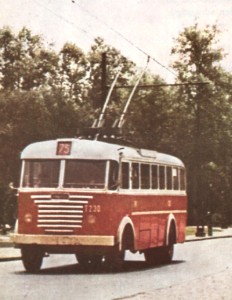 |
|
|
|
|
The
Ikarus 60 trolleybus,
articulated trolleybuses and trailers |
|
 |
|
|
|
>> |
articulated >> |
articulated>> |
>> |
|
|
|
|
|
|
|
|
|
|
|
|
|
|
|
|
|
|
|
|
|
|
|
|
|
|
|
|
|
|
|
|
|
|
|
|
|
|
|
86 kW |
86 kW |
86 kW |
|
|
|
|
5750 mm 1400 mm |
5800 mm |
|
|
|
|
|
|
|
|
|
|
|
|
|
Statistics of the new trolleybuses:
year 1952. 1953. 1954. 1955. 1956. new trolleybuses (pieces) 8 17 73 37 22 numbers T200-T207 T208-T224 T225-T297 T298-T334 T335-T356
| In the revolution of 1956 two IK-60T trolleybuses were damaged beyond
the possibility of repairation. These two were the T320 and T354,
that were barely one year old.
The construction of IK-60 was though quite massive. For example it was at this time usual, that the buses and trolleybuses were pushing each other without a risk of any serious damage. In the '70s the buses of line 9 were giving a saving kick to the trolleybuses of line 74, that often stuck in the extra long insualtion of the tram crossings at Kálvin tér (square). On the other hand the trolleybuses were pushing the the FAÜ (Capitol Autobus Service)-articulated buses at the stops, since the buses' motors sometimes stalled. (From the stories of the drivers, after a while there was no need to demand: if a bus was waiting too long with closed doors in the stop, the trolleybus automaticly started to push it.) And furthermore it happened not once, that a broken down trolleybus was pushed by an other one from the city centre to the depot at Pongrác út (street). |
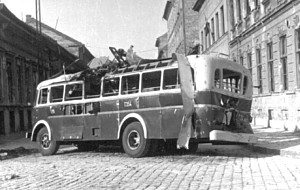 The damaged T354 trolleybus in the fights of 1956. |
| In 1960 started the service of trolleybuses with trailers.
For this reason many cars were equipped with hauling device, with strengthening
also the rear of the chassis. Alltogether 58 solo cars became suitlable
to pull a trailer (interesting is, that 59 trailer were in service at this
time). In 1962 the numbers of the traction trolleybuses (300 series) were
separated from the rest of solo cars (200 series). With this renumbering
the letter T is disappeared.
On the right picture it is to be noticed, that the trolleybuses of the FVV were painted and not sprinkled (as the buses). The employees made a good job: the polish was spotless of the repainted cars. Also the dark red livery was continued in the rear to the top of the trolleybuses from the '60s - with painting the roof red too. In 1961 started the rebuilding of the IK-60T trolleybuses to articulated vehicles: alltogether 53+1 cars were converted. This became the 400 series. |
On the rear is written "Drive without accidents!". |
| Inside the trolleybuses were seats in 2+1 row. After 1958 the guided
flow of passenger was introduced, at the rear door was the entry, with
this a conductor seat was placed near there. This system lasted until 1966.
The lights inside were operating from the line voltage (550 V), there were bulbs coupled in series. On insulated tracks (e.g. at tram crossings) supplementary lights were operating near the doors from accumulator. The doors were automatic operated by the driver with high pressure air. |
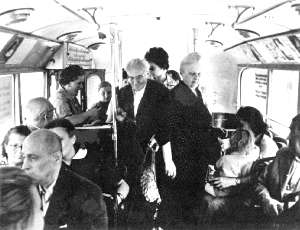 Inside IK-60T, the rear door and the conductor's seat. |
| The driver's cabin was separated by a dark wall with three assymetric
windows (on the left between two windows was a hole). There was no passage
between the drivers cabin and the room, the driver could get on through
a door on the left.
On the trolleybus the right door was missing in the front (the buses had one) - since here was the place of the electric equippment in boxes. On the picture one can spot the fuse switch too above the driver's seat. |
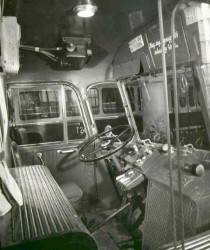 The driver's cabin of the IK-60T trolleybus |
The trolleybus was electrically similar construction as the type MTB-82. They had direct controller on the accelerator and the brake, which pedals were on the right and left of the steering wheel. So the driving technique was similar: with the accelerator could the driver increase the speed until 20 km/h in 8 cascade, then till 50-60 km/h with the 3 shunt-cascades. With taking back the the accelerator pedal to the 8th position it was possible to brake and recuperate, which was automatically changing to rheostatic brake when the network had no capacity to the recuperation. The brake pedal had 3 cascades of rheostatic brake, and then the air-pressure brake.Naturally the recuperative brake (wich was regulated with the accelerator) had used the red brake lights at the end. But the operating relay was sometimes not well adjusted: so the brake signals were lit also during the accelerations.
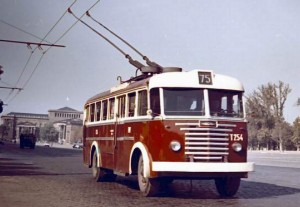 |
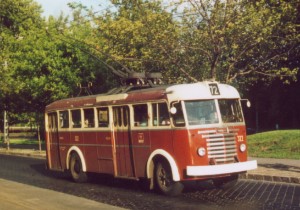 |
|
This trolleybus became 232 in 1962, soon it was rebuilt as an articulated car 440. |
|
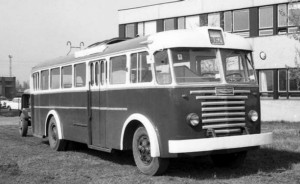 |
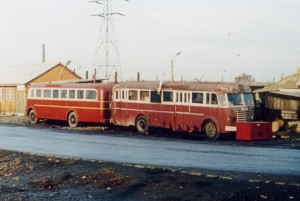 Sándor Ambrus
|
|
|
On the picture: two scrapped solo trolleybuses. |
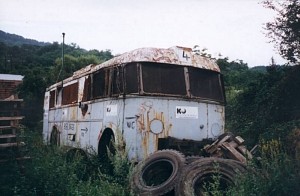 Zoltán Gábor Németh
|
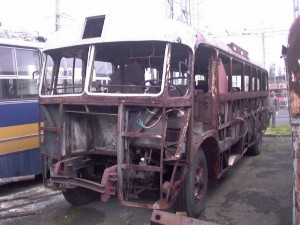 Dávid Vitézy
|
|
|
This wreck is guarded at Pongrác út (street) depot, for later renovation. But right now it is in a very depressing condition. |
Because of the increasing traffic, in 1954 the FAÜ (Capitol Autobus
Service) introduced the trailers with traction autobuses. The FVV (Capitol
Tramways) started the trailer service at the trolleybus-servce only later:
the first series of trailers - made by ÁMG (General Mechanical Machine
Factory in Székesfehérvár) - came in 1960. Until 1961, the trailers obtained
the numbers TP000-TP054.
From 1st June, 1962 the trailers were in the number group starting from 900. There was alltogether 59 trailers in the the FVV's vehicle-park, amongst them the 921-940 were supplied brand new, the rest was overtaken from FAÜ. |
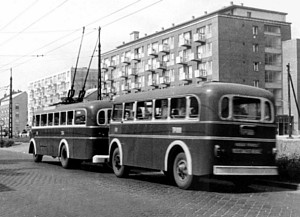 Trailer on the Hungária körút (boulevard) around 1960. It is hard to read, but this trailer has possibly the number TP0xx. |
||||||||||||
| The 59 trailers were not completely identical: there were cars, that
had a dashboard familiar to the IK-620 series of autobuses (though its
main sizes were similar to IK-60). Possibly this series were the 20 new
trailers.
The trailers had normally steered first axle, which was driven by the hauling gear (so it was more complicated than todays' lorries' trailers). There was a pressure air (break) and electric coupling between the traction trolleybus and the trailer. Originally these vehicles were planned to be hauled by autobuses, so it is not suprising, that the main voltage was not lead into the trailer, and in the trailer had lighting operating from accumulator (but not on the hauling part - so on the insulated sections e.g. tramway crossings the front part's lighting was off, while in the trailer's possibly stayed!). |
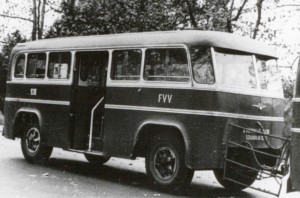 The trailer 938. The dashboard of this car is similar to IK-620. |
The door of the trailer was operated with pressure air, to the signals of the conductor (other sources say that the coductor operated the doors). In the trailer worked a sitting conductor, but this job ended on 4th October in 1964. Since 1st July 1966 the whole conductor service was replaced by the new ticket system in Budapest.It wasn't an easy job to drive a hauling trolleybus. For the city centre lines they weren't suitable since the trailer was more inside than the front in turns. It was hard to brake too, since the trailer wasn't braking with rheostatic brake. The driver had to take care especially in slippery weather, in unguarded moments the trailer was able to overtake the hauling trolleybus. (Also the articulated buses are not safe from this behavior).
The trailer service was working almost without exception on the line 75 until 1968. After the trailers were scrapped.
year 1965. 1967. 1968. scrapped trailers (pieces) 1 20 38 Many of them became the property of companies in the building industry. So even today it is possible to find some (in bad state): the 923 is awaiting its reconstruction for exhibition at the ex-Sallai workshops.
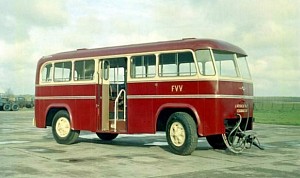 |
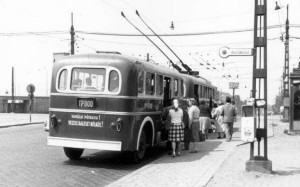 |
|
|
|
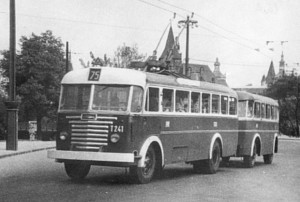 |
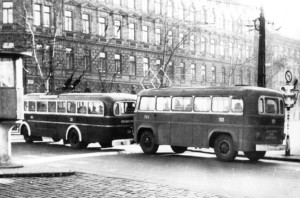 |
|
|
The coupling of the pressure air is possible to spot. |
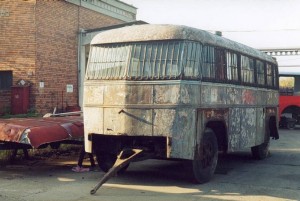 Ferenc Tóth
|
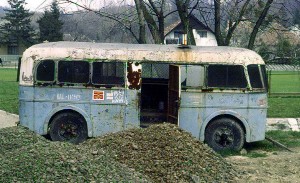 Tibor Tildy
|
|
|
|
After the success of the FAÜ-articulated buses (the first of them was made in 1960) the IK-60T trolleybuses were also involved in the production of articulated vehicles. First a four-axle trolleybus was made at Sallai-workshop's "articulated string": this car obtained the number T400. The electric equippment was remounted at Pálffy workshop, its trial run around the workshop began on 8th May 1961.Originally the motored part was T283, for the trailer another IK-60 autobus was used. Its rear twin-axles were steered, so there was no problem to manoeuvre in the city centre with the long vehicle. The trolleybus got the usual dark red-white livery with red roof, but the shape of the radiator was redesigned giving a new look to the front.
Its first public appearance was during the BNV (Budapest International Fair), shortly after it run at line 70/A (Nagymező utca (street) - Erzsébet királyné útja (street)) serving the visitors of the fair. The construction was not excellent, because the trolleybus was slow with its original 116,8 HP motor. It was scrapped relativly soon on 20th May 1967.
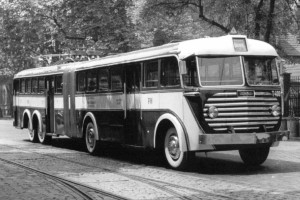 |
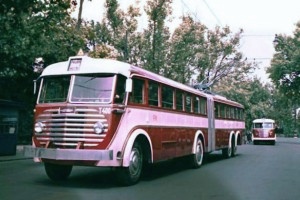 |
|
|
|
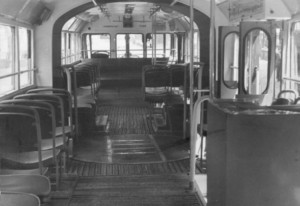 Géza Gyulai
|
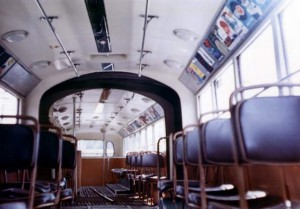 |
|
|
|
The production of the series of
articulated trolleybuses started in 1962, the trolleybus 401 was
ready on 29th March 1962; the last 53rd car had its official exam on 4th
January 1964.
The series of the articulated trolleybuses were made from IK-60T front and TR 5 autobuses as a trailer (the TR 5 type was a predecessor of the IK-60 series made in the end of the '40s) at Sallai workshop. The electric parts were yet again installed at Pálffy workshop - with the remount of the original equippment of IK-60T. |
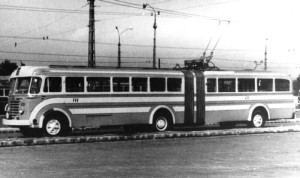 |
|||||||||||||
|
This car has possibly green coloration with cream-yellowish stripes. |
||||||||||||||
It is worthwile to mention, that the main parameters of the TR 5's frame and body were slightly different from IK-60. The width and height of the windows were noticeably different. The width of the frame was less with 2 cm, and inside the roof had other shape in the frontal and the end part. The rear axle of this construction was again steered - so the trolleybus was able to turn in a radius of 11 m. As the weight on the rear axle was higher, here the vehicle was fitted with a larger and wider tyre.The trailers of the 451 and 453 were converted from the military version of TR 5 (which only later became the property of FAÜ). These buses didn't have sank platform at the deck, so at the rear doors also were two steps. The two trolleybuses inherited this peculiar rear outfit.
The designers of the IK-60T did not content with the novelty of articulated trolleybuses, they invented new livery schemes too. Instead of the original dark red coloration, they began to use orange or green fund-colour with creme-yellowish or blue stripes. On the different line-groups were supposed to run different colour vehicles:
- on 70-78 orange-creme,
- on line 73 orange-blue,
- on line 74 green-creme coloured trolleybuses.
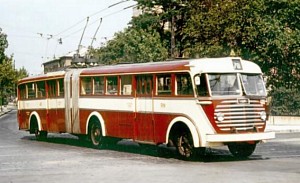 |
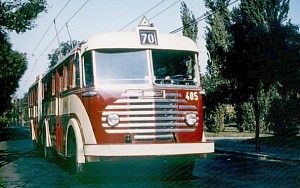 |
|
|
This car has the usual red-white livery, but the radiator has similar shape as T400. |
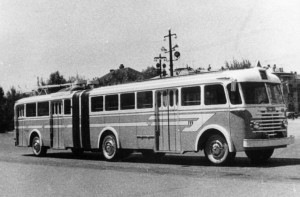 |
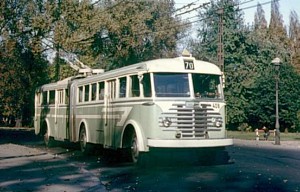 |
|
|
The shape of the radiator was changed, and the trolleybus obtained special wheel trims. |
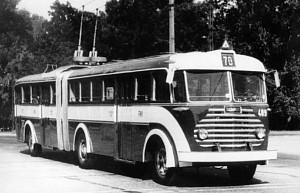 |
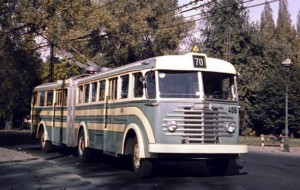 Nagy Zsolt Levente gyűjteménye
|
|
This is still the original red-white coloration of the articulated trolleybus. |
Here the usual tone of the green livery is observable. Notice, that this car is supplied only with the original small round mirrors (comparing to the earlier cars' greater mirrors). |
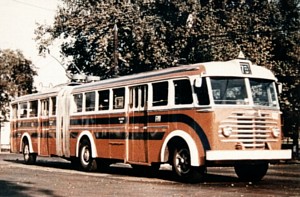 |
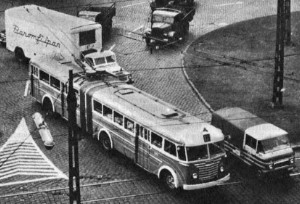 Magazine Autó-Motor
|
|
Here the orange is with blue stripes. Possibly this car was originally intended to run at line 73. |
On this trolleybus the blue stripes are again different: the edge of the stripes are stressed. The later series kept the original radiator of IK-60T. |
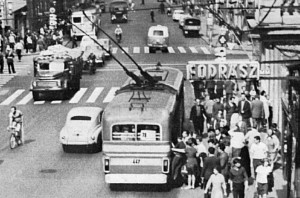 |
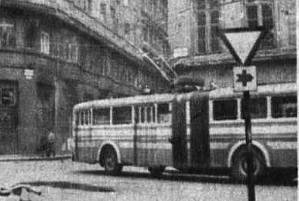 Magazine Autó-Motor
|
|
Possibly this trolleybus is a green one, since some sources claim, that from 438 the trolleybuses had green colour with cream-yellowish stripes. According to the picture from a certain point nobody cared about the colour of the car working on a certain line. On the articulated trolleybuses were guided flow of passangers: the entry was only at the rear door - if it was possible to enter... |
Again this is supposed to be a green car (now in reality what colour is it?). |
The FVV was unable to repair the many varieties of liveries, so not suprisingly from the middle of the '60s the original red-white coloration became again the standard outfit. Also with the repairs the unique radiators were changed back to the usual.
| The articulated vehicles run first on the city centre lines, especially
on line 70, 73, 74 and 78. From 1967-68 all the 53 cars became the fleet
of line 75.
The fleet was right enough for line 75, since by this time 43 cars ran here weekdays. This was an extremly frequent traffic: less than 2 minutes was between the trolleybuses. In around 1968 (at the time of the formation of BKV - Budapest Traffic Company) the usual coloration was dark red-white: with the white stripe lasting only until the driver's door. |
|
| The 400 series trolleybuses remained on line 75 until 1976. This was
the time, when the new 100 series Ikarus-BKV IK-280T trolleybuses began
to replace them (shortly then they were on line 79 too).
So the articulated trolleybuses without work were scrapped. Most of them were cut into pieces, some of the cars were stored at Gvadányi út (street) for some time, but these trolleybuses also disappeared soon. By today's knowledge there is no remaining articulated trolleybus from the 400 series. |
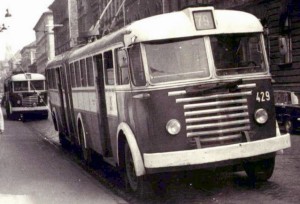 Articulated car 429 at terminus Garay utca. |
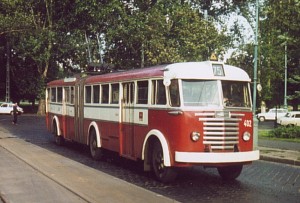 |
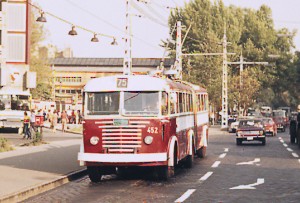 Peter Makinson
|
|
|
|
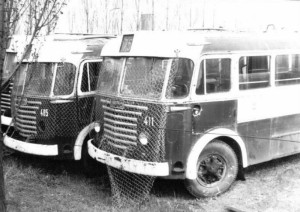 |
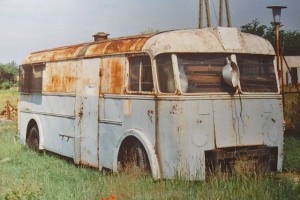 Ákos Babiczky
|
|
|
|
Rear lights:
Maybe it is not suprising, that the IK-60T's rear lights had an "evolution" too. Here is a bunch of them:
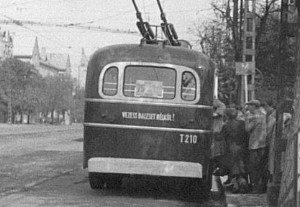 From the homepage of Zoltán László
|
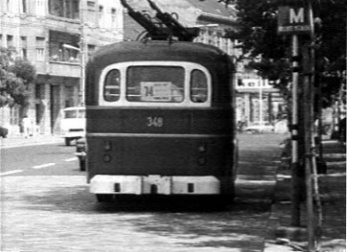 |
|
The picture was taken at Népliget (Common Park) terminus of line 75. A loop of cable is recognisable in the background: this was the "small loop" which was used at the time, when inside the park was a race (the normal loop of the terminus was partly on the race-track). |
From the number it is obvious that this was formally a traction trolleybus - the coupling device is noticable. However the pipe of the pressure air brake is disappeared. |
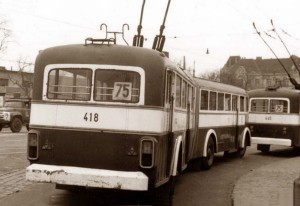 József Jobbágy
|
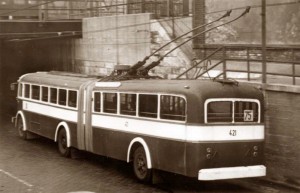 József Jobbágy
|
|
The articulated trolleybuses were fitted with a joint signal lights at the rear, which was also used on IK-620 buses. The production of these joint lights were ceased later. |
On many articulated trolleybuses the rear lights were exchanged - similarly to the IK-620 type - to individual lamps. The difference was, that these lamps were situated vertically on the trolleybuses. |
|
|
|
|
|
|
|
|
|
|
|
|
|
|
|
|
|
|
|
|
|
|
|
|
|
|
|
|
|
|
|
|
|
|
|
|
|
|
|
|
|
|
|
|
|
|
|
|
|
|
|
|
|
|
|
|
|
|
|
|
|
|
|
|
|
|
|
|
|
|
|
|
|
|
|
|
|
|
|
|
|
|
|
|
|
|
|
|
|
The renumbering to 300 series (traction trolleybuses) in 1962:
|
|
|
|
|
|
|
|
|
|
|
|
|
|
|
|
|
|
|
|
|
|
|
|
|
|
|
|
|
|
|
|
|
|
|
|
|
|
|
|
|
|
|
|
|
|
|
|
|
|
|
|
|
|
|
|
|
|
|
|
|
|
|
|
|
|
|
|
|
Renumberings with the building of articulated trolleybuses (400 series):
|
|
|
|
|
|
|
|
|
|
|
|
|
|
|
|
|
|
|
|
|
|
|
|
|
|
|
|
|
|
|
|
|
|
|
|
|
|
|
|
|
|
|
|
|
|
|
|
|
|
|
|
|
|
|
|
|
|
|
|
|
|
|
|
|
|
|
|
|
2005.XI.